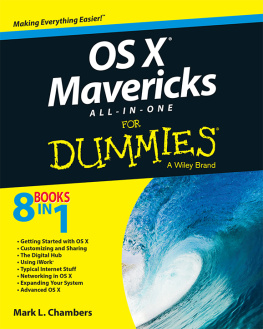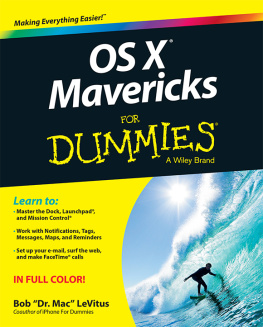Michael E. Cohen
2014 Michael E. Cohen
Read Me First
Welcome to Take Control of Pages, version 1.0, published in December 2014 by TidBITS Publishing Inc. This book was written by Michael E. Cohen and edited by Tonya Engst and Kelly Turner.
This book introduces you to all three current versions of Apples word processor: Pages 5 for Mac, Pages for iOS, and Pages for iCloud. It describes how to create, work on, and share documents among devices and users, and provides transition help for users of Pages 4.
If you want to share this ebook with a friend, we ask that you do so as you would with a physical book: lend it for a quick look, but ask your friend to buy a copy for careful reading or reference.
Copyright 2014, Michael E. Cohen. All rights reserved.
Updates and More
You can access extras related to this ebook on the Web (use the link in , near the end; its available only to purchasers). On the ebooks Take Control Extras page, you can:
- Download any available new version of the ebook for free, or buy any subsequent edition at a discount.
- Download various formats, including PDF, EPUB, and Mobipocket. (Learn about reading on mobile devices on our Device Advice page.)
- Read the ebooks blog.
If you bought this ebook from the Take Control Web site, it has been added to your account, where you can download it in other formats and access any future updates. However, if you bought this ebook elsewhere, you can add it to your account manually; see .
Note: To review background information that will help you understand this book better, such as how to find System Preferences and work with files in the Finder, read Tonya Engsts free ebook Read Me First: A Take Control Crash Course.
Introduction
When Apple released Pages 5 for Mac in late 2013, along with revamped versions of its iOS siblings, there was much wailing and gnashing of teeth from long-time Pages users: Apple had rewritten the app from top to bottom, almost completely changing its look and feel, and, in the process, eliminating many useful features. The cry of Why, Apple, why? was heard throughout the land.
The answer was difficult to discern at the time, but over the following year, as this book was being drafted (and released in pre-book installments), and as Pages went from version 5 to 5.1 to 5.2 and now to 5.5, the answer became much clearer: iCloud.
As Apple CEO Tim Cook remarked about iCloud in 2012, Its not just a product, its a strategy for the next decade, and the revision of Pages, along with updates to the other iWork apps, was part of that strategy. The idea was to make your Pages documents available everywhereon your Mac, on your iPhone and iPad, and even in a Web browservia iCloud.
True, Apple could have tried to bolt more iCloud compatibility onto the existing Pages app, but the result, like building a luxury penthouse atop a split-level ranch house, would have been both ugly and unstable. Instead, Apple rebuilt everything about Pages, from its user interface to the file structure of its documents, so that Pages documents created on one device, like a Mac, could readily be opened and edited on any other device running Pages, whether the device was another computer or an iPad, iPhone, or iPod touch.
The goal was to make Pages not just a word processor but an example of what iCloud integration could provide. Over the year that followed, just what that integration could provide came into sharper focus.
Today, courtesy of iOS 8 and OS X 10.10 Yosemite, you can open a Pages document on your Mac, and then without bothering to save or sync your document, walk out your front door, open Pages on your iPhone, and continue working on the document while waiting for your bus to arriveand then, at your office, open up Internet Explorer on your Windows desktop and continue working on that same document.
Pages is still not done. Throughout 2014, Apple continued to add back features that it had sidelined in the original release of Pages 5, and I dont think Apple is done expanding and enhancing it. Moreover, Apple has made it clear that the future is more important to it than the past: each new release of Pages not only takes advantage of, but depends on, the latest versions of OS X and iOS. Thats why this book does not try to cover Pages on 10.9 Mavericks or iOS 7 (though much in it is applicable to Pages on them)the latest releases of the Pages apps wont even run on those older systems!
Instead, the book you have before you describes how Pages works today on the latest incarnations of Apples OSes, and attempts to explain how to get your work done with it, not just on your Mac but on all your iOS devicesand in any modern Web browser that you happen to have in front of you.
Describing how Pages works on three different platforms has not been an easy task, and has resulted in a much longer book than Take Control ordinarily publishes. But to focus on just, say, the Mac version of Pages would have been almost pointless. These days we arent just Mac users, or iPad users, or iPhone users: we are Apple users, and many of us, perhaps a majority of us, do not confine our work (or our play) to any single Apple platform.
In my introduction to the first pre-book, I rewrote a line from David Copperfield: But whether Apple has met its design goal of cross-platform cloud-based bliss, these pages must show. Now, at the end of this year-long journey, I can honestly say that Apple has come closer to that goal than I had originally expected.
Note: Pages 5.5 requires at least OS X 10.10 Yosemite; Pages for iOS requires iOS 8.

















